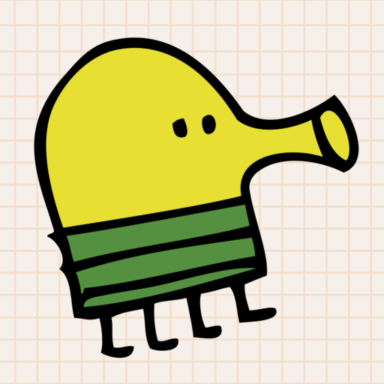The German silent film Die Puppe/The Doll (1919) is a charming romantic fantasy directed by Ernst Lubitsch. The splendidly original film is loosely based on the short story by E.T.A. Hoffmann, which also inspired the ballet Coppélia.
German postcard by Ross Verlag, Berlin, no. 635/4 1919-1924. Photo: Union. Publicity still for Die Puppe/The Doll (Ernst Lubitsch, 1919) with Ossi Oswalda and Hermann Thimig.
In the opening shot of Die Puppe/The Doll,Ernst Lubitsch sets up a doll's house against a stylised backdrop. A close-up of this model then dissolves into a full-sized version of the same stylised setting, from which emerge actors dressed as dolls. From this point onward, the entire film is staged on highly stylised sets.
The old Baron von Chanterelle (Max Kronert) has no family except for his gormless nephew Lancelot (Hermann Thimig). He wants to preserve his family line, so he forces Lancelot to choose one of the village maidens to wed.
Lancelot flees to a monastery to escape the forty eager maidens. The Baron offers his nephew a dowry of 300,000 francs to get married. But Lancelot is afraid of women.
The prior (Jacob Tiedtke) shows him an advertisement from the doll-maker Hilarius (Victor Janson), who offers a special service 'for bachelors, widowers and misogynists': a life-size clockwork girl! Lancelot decides to marry the mechanical bride, collect the dowry, then stash the doll in the attic.
Hilarius has just finished making a replica of his pretty daughter Ossi (Ossi Oswalda). The clockwork girl has a control panel on her back and a crank to wind her up.
The doll-maker's young apprentice (Gerhard Ritterband) accidentally breaks the arm of the doll and convinces the real Ossi to mimic the doll. Lancelot buys her, thinking she is a doll, and takes her back to the monastery, where they are wed.
Ernst Lubitsch and Ossi Oswalda. German postcard by Ross Verlag, Berlin, no. 337/1, 1919-1924. Photo: Zander & Labisch.
Ernst Lubitsch once wrote to his biographer Herman G. Weinberg that he considered Die Puppe and Die Austernprinzessin/The Oyster Princess (1919) as his most outstanding comedies produced in Germany before he departed for Hollywood to make Rosita (1923).
Die Puppe/The Doll features, according to F Gwynplaine MacIntyre at IMDb, 'an extremely kinky performance' by Ossi Oswalda: "In a frilly outfit with a short skirt, Ossi is very pretty as both the mechanical girl and the real one. There is some surprisingly good double-exposure in a couple of camera set-ups when the real Ossi and the mechanical one are onscreen simultaneously. Brilliant camerawork throughout by the great Theodor Sparkuhl."
The great charm of Die Puppe is its mood of fairy-tale unreality. The coachman's horses are played by men in pantomime-horse costumes. A cat and a rooster are played by cut-out figures. The moon has a human face.
F Gwynplaine MacIntyre at IMDb: "I enjoyed a bizarre scene in which an entire roomful of mechanical girls dance for Lancelot. The sequences of Ossi (the real one) dancing stiffly while pretending to be a clockwork girl remind me of the sequence in Metropolis when the female robot takes her first awkward steps. The Doll is an absolute delight from beginning to end, a film that the entire family will enjoy."
German postcard by Ross Verlag, Berlin, no. 635/5 1919-1924. Photo: Union. Publicity still for Die Puppe/The Doll (Ernst Lubitsch, 1919) with Ossi Oswalda and Hermann Thimig.
Sources: F Gwynplaine MacIntyre (IMDb), Will Gilbert (IMDb), Wikipedia and IMDb.
German postcard by Ross Verlag, Berlin, no. 635/4 1919-1924. Photo: Union. Publicity still for Die Puppe/The Doll (Ernst Lubitsch, 1919) with Ossi Oswalda and Hermann Thimig.
A special service for bachelors, widowers and misogynists
In the opening shot of Die Puppe/The Doll,Ernst Lubitsch sets up a doll's house against a stylised backdrop. A close-up of this model then dissolves into a full-sized version of the same stylised setting, from which emerge actors dressed as dolls. From this point onward, the entire film is staged on highly stylised sets.
The old Baron von Chanterelle (Max Kronert) has no family except for his gormless nephew Lancelot (Hermann Thimig). He wants to preserve his family line, so he forces Lancelot to choose one of the village maidens to wed.
Lancelot flees to a monastery to escape the forty eager maidens. The Baron offers his nephew a dowry of 300,000 francs to get married. But Lancelot is afraid of women.
The prior (Jacob Tiedtke) shows him an advertisement from the doll-maker Hilarius (Victor Janson), who offers a special service 'for bachelors, widowers and misogynists': a life-size clockwork girl! Lancelot decides to marry the mechanical bride, collect the dowry, then stash the doll in the attic.
Hilarius has just finished making a replica of his pretty daughter Ossi (Ossi Oswalda). The clockwork girl has a control panel on her back and a crank to wind her up.
The doll-maker's young apprentice (Gerhard Ritterband) accidentally breaks the arm of the doll and convinces the real Ossi to mimic the doll. Lancelot buys her, thinking she is a doll, and takes her back to the monastery, where they are wed.
Ernst Lubitsch and Ossi Oswalda. German postcard by Ross Verlag, Berlin, no. 337/1, 1919-1924. Photo: Zander & Labisch.
An extremely kinky performance
Ernst Lubitsch once wrote to his biographer Herman G. Weinberg that he considered Die Puppe and Die Austernprinzessin/The Oyster Princess (1919) as his most outstanding comedies produced in Germany before he departed for Hollywood to make Rosita (1923).
Die Puppe/The Doll features, according to F Gwynplaine MacIntyre at IMDb, 'an extremely kinky performance' by Ossi Oswalda: "In a frilly outfit with a short skirt, Ossi is very pretty as both the mechanical girl and the real one. There is some surprisingly good double-exposure in a couple of camera set-ups when the real Ossi and the mechanical one are onscreen simultaneously. Brilliant camerawork throughout by the great Theodor Sparkuhl."
The great charm of Die Puppe is its mood of fairy-tale unreality. The coachman's horses are played by men in pantomime-horse costumes. A cat and a rooster are played by cut-out figures. The moon has a human face.
F Gwynplaine MacIntyre at IMDb: "I enjoyed a bizarre scene in which an entire roomful of mechanical girls dance for Lancelot. The sequences of Ossi (the real one) dancing stiffly while pretending to be a clockwork girl remind me of the sequence in Metropolis when the female robot takes her first awkward steps. The Doll is an absolute delight from beginning to end, a film that the entire family will enjoy."
German postcard by Ross Verlag, Berlin, no. 635/5 1919-1924. Photo: Union. Publicity still for Die Puppe/The Doll (Ernst Lubitsch, 1919) with Ossi Oswalda and Hermann Thimig.
Sources: F Gwynplaine MacIntyre (IMDb), Will Gilbert (IMDb), Wikipedia and IMDb.


